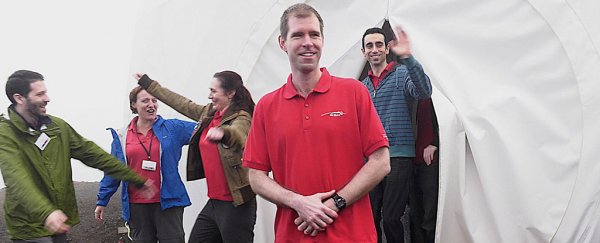The longest-running NASA experiment of its kind designed to simulate living conditions on Mars has come to an end, with six volunteers emerging from a year-long stay in a sealed dome in Hawaii.
For 365 days, the HI-SEAS (Hawaii Space Exploration Analog and Simulation) crew lived in isolation in a geodesic dome on the barren slopes of the Big Island's Mauna Loa, with the rocky, sparse terrain outside chosen for its similarity to the red planet's natural environment.
During the year, the team members could only leave their sealed habitat wearing space suits, and their only contact with the outside world came in the form of emails – which were delayed for 20 minutes either way, so as to emulate how long actual emails would take to send between Earth and Mars.
The experiment – funded by NASA and run by the University of Hawaii – is the longest yet in a series of ongoing HI-SEAS simulations designed to see how scientists cope with the extreme, long-term isolation that would have to be endured by astronauts and researchers during a real-life Mars mission.
While previous jaunts have seen scientists enclosed in the habitat for up to eight months, this team set a new NASA record by lasting an entire year.
But they're nowhere near the effort of Europe and China's Mars–500 team, who participated in a similar experiment between 2007 and 2011, and managed to last a staggering 520 days in a Mars simulation.
The tone from the latest HI-SEAS crew is upbeat and optimistic, suggesting that the emotional and technical rigours of a long-term stay in a sealed-off space dome are not unviable for future travellers to the red planet.
"I can give you my personal impression which is that a mission to Mars in the close future is realistic," said one of the team, French astrobiologist Cyprien Verseux. "I think the technological and psychological obstacles can be overcome."
In addition to Verseux, the crew consisted of a physicist, an architect, a soil scientist, a neuroscientist, and an engineer.
This bunch not only had to contend with being isolated from the rest of humanity, but also with having to live in such close proximity to each other in extremely confined quarters – the dome measures just 11 by 6 metres (36 by 20 feet).
"It is kind of like having roommates that just are always there and you can never escape them," mission commander Carmel Johnston told media this week, "so I'm sure some people can imagine what that is like, and if you can't then just imagine never being able to get away from anybody."
Everything the crew survived on during their year 'on Mars' they had to bring with them, meaning they essentially ate a lot of things like powdered food and canned tuna.
In addition to serving as guinea pigs so we can better understand the psychological effects of spending so long in a sealed environment, the researchers also ran a number of experiments, such as examining how to extract water from arid terrain, which could end up meaning the difference between life and death on Mars.
"Showing that it works, you can actually get water from the ground that is seemingly dry," said German researcher Christiane Heinicke. "It would work on Mars and the implication is that you would be able to get water on Mars from this little greenhouse construct."
But the biggest challenge was staving off boredom, with the team having to devise ways of keeping themselves entertained, such as learning salsa dancing and playing the ukulele.
"We were always in the same place, always with the same people," Verseux said.
His advice to new volunteers who will take part in new long-term HI-SEAS isolation experiments beginning in 2017 and 2018? "Bring books."
The team is now being debriefed, and research looking at how well they fared psychologically during their 12 months of isolation is expected to be published in the coming months.
And the sweet part of the deal for us is that, since NASA recently made all the research it funds available for free, we won't have to wait too long to find out just what happens during a year in (almost) space.
But for now, the researchers are entitled to a holiday, and what better place to enjoy a little R&R than Hawaii? And you don't just have to take it from me:
Congrats to NASA and the scientists taking us a step closer to Mars. Now enjoy Hawaii and get a shave ice! https://t.co/lFZjSnn38x
— President Obama (@POTUS44) August 29, 2016
